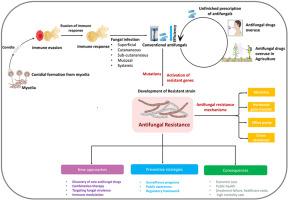The hidden threat: Unveiling the rise of antifungal drug resistance
IF 3.5
3区 医学
Q3 IMMUNOLOGY
引用次数: 0
Abstract
Fungal pathogens are increasingly recognized as a significant threat to global health, particularly for individuals with weakened immune systems, such as those with cancer or HIV/AIDS. Current antifungal treatments are limited and the development of new therapies has been slow due to the similarities between fungi and humans, limiting drug target options. The rise of drug-resistant strains, has led health organizations to classify antifungal resistance (AFR) as a critical global issue. AFR can develop through various mechanisms including change in drug target, enhanced activity of efflux pumps, and activation of cellular stress response, all of which reduce the effectiveness of standard antifungal therapies. This resistance develop either during antifungal treatment as a result of genetic mutations or through environmental exposure, especially in agriculture where azole based fungicides are extensively used. Despite its rising impact on global health, AFR has not received the same attention as bacterial resistance, highlighting the need for more effective surveillance and control measures. This review discusses the molecular and environmental factors contributing to AFR and highlights various strategies to combat it, such as use of combination therapies, targeting fungal virulence factors and advancements in diagnostic and surveillance system. In addition, the development of novel antifungal drugs, evaluation of immune-based therapies, better education, and training of healthcare professional are vital for effectively managing and mitigating AFR.

隐藏的威胁:揭示抗真菌药物耐药性的上升。
真菌病原体日益被认为是对全球健康的重大威胁,特别是对免疫系统较弱的个体,如癌症或艾滋病毒/艾滋病患者。目前的抗真菌治疗是有限的,由于真菌和人类之间的相似性,限制了药物靶点的选择,新疗法的发展一直很慢。耐药菌株的增加导致卫生组织将抗真菌耐药性(AFR)列为一个关键的全球问题。AFR的发生机制多种多样,包括药物靶点改变、外排泵活性增强、细胞应激反应激活等,这些都降低了标准抗真菌治疗的有效性。这种耐药性要么是在抗真菌治疗期间由于基因突变而产生的,要么是由于环境暴露而产生的,特别是在广泛使用唑基杀菌剂的农业中。尽管非洲猪瘟对全球卫生的影响越来越大,但它并没有像细菌耐药性那样受到同样的重视,这突出表明需要采取更有效的监测和控制措施。本文综述了导致AFR的分子和环境因素,并重点介绍了治疗AFR的各种策略,如联合治疗、靶向真菌毒力因子以及诊断和监测系统的进展。此外,新型抗真菌药物的开发、免疫疗法的评估、更好的教育和卫生保健专业人员的培训对于有效管理和减轻AFR至关重要。
本文章由计算机程序翻译,如有差异,请以英文原文为准。
求助全文
约1分钟内获得全文
求助全文
来源期刊

Microbial pathogenesis
医学-免疫学
CiteScore
7.40
自引率
2.60%
发文量
472
审稿时长
56 days
期刊介绍:
Microbial Pathogenesis publishes original contributions and reviews about the molecular and cellular mechanisms of infectious diseases. It covers microbiology, host-pathogen interaction and immunology related to infectious agents, including bacteria, fungi, viruses and protozoa. It also accepts papers in the field of clinical microbiology, with the exception of case reports.
Research Areas Include:
-Pathogenesis
-Virulence factors
-Host susceptibility or resistance
-Immune mechanisms
-Identification, cloning and sequencing of relevant genes
-Genetic studies
-Viruses, prokaryotic organisms and protozoa
-Microbiota
-Systems biology related to infectious diseases
-Targets for vaccine design (pre-clinical studies)
 求助内容:
求助内容: 应助结果提醒方式:
应助结果提醒方式:


